
Rescuing tortoises
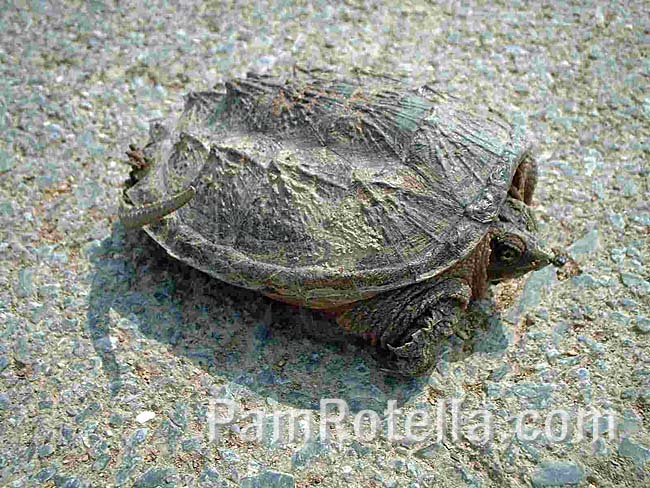 Tortoises are land animals; turtles are water animals. Usually the shape of their shells help differentiate the two -- the tortoise's shell needs to be higher, to dissipate heat from the sun. A turtle's shell can be flatter and smoother, to cut down water resistance when swimming. So this looks like a tortoise, not a turtle. It's the second tortoise I've rescued from a road to reduce its immediate chances of becoming road kill. The first was on a highway near Englewood Florida in 1998. The tortoise in '98 was much larger -- bigger than a dinner plate, and several inches tall. It was jet black, crossing a rural road with black pavement. Although the road was rural, of course a red car immediately came up behind me at high speed -- a very low sports car. I thought the tortoise was done for. Fortunately, the man in the red car saw the tortoise, so he stopped to let me pick it up. The tortoise was very warm to the touch, and didn't seem to appreciate the help. It had no fear of me, turning its head around to give me a grumpy look. Fortunately, its shell was so large that its neck couldn't reach back far enough to bite my hands. I left it in tall grass, in the direction it had been walking.
Tortoises are land animals; turtles are water animals. Usually the shape of their shells help differentiate the two -- the tortoise's shell needs to be higher, to dissipate heat from the sun. A turtle's shell can be flatter and smoother, to cut down water resistance when swimming. So this looks like a tortoise, not a turtle. It's the second tortoise I've rescued from a road to reduce its immediate chances of becoming road kill. The first was on a highway near Englewood Florida in 1998. The tortoise in '98 was much larger -- bigger than a dinner plate, and several inches tall. It was jet black, crossing a rural road with black pavement. Although the road was rural, of course a red car immediately came up behind me at high speed -- a very low sports car. I thought the tortoise was done for. Fortunately, the man in the red car saw the tortoise, so he stopped to let me pick it up. The tortoise was very warm to the touch, and didn't seem to appreciate the help. It had no fear of me, turning its head around to give me a grumpy look. Fortunately, its shell was so large that its neck couldn't reach back far enough to bite my hands. I left it in tall grass, in the direction it had been walking.Notice how today's tortoise (pictured above) blends in with the road. Its multi-colored gray pattern makes it hard to discern from rocks and pavement. Of course as soon as I pulled over to move it out of danger, a big truck had to speed past on the usually-deserted road. It missed hitting the tortoise by an inch or two. The tortoise is so small and well-camouflaged that it probably looked like a small rock on the pavement. After the truck passed, I ran back to get the tortoise, and took it to the road's shoulder in front of my car for protection. It was much more timid than the Florida tortoise, having retreated into its shell as much as possible with its eyes closed. I wasn't sure if it had been hit by a car or not, as it had some brown-colored goo, quite sticky, coming out of its sides below its shell. I don't know if this is a defense mechanism or an injury. However, it was feeling well enough to close and open its eyes, and pull in its limbs. At least it was conscious, although it didn't walk at all while I was there.
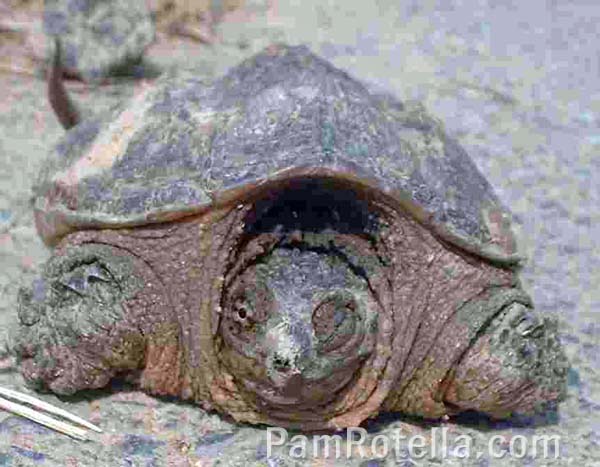 This time I had a camera with me, so while it refused to move I decided to take a few pictures. After a minute, the tortoise finally opened one eye to look at me with my camera. Surprisingly, it didn't shut its eye after seeing me. In the picture to the left, its one open eye has horizontal dark markings, almost making the open eye look closed.
This time I had a camera with me, so while it refused to move I decided to take a few pictures. After a minute, the tortoise finally opened one eye to look at me with my camera. Surprisingly, it didn't shut its eye after seeing me. In the picture to the left, its one open eye has horizontal dark markings, almost making the open eye look closed.The tortoise was obviously intimidated by my size, and had no interest in moving. However, it was becoming more relaxed. Its head and legs were starting to come out again. It appeared to be incapable of pulling its tail in. Now that it seemed ready for relocation, I decided to give it a quick check, then find a safer place to put it. I realized that relocating it a few feet from the road wouldn't guarantee its survival. It's most likely that the tortoise will simply walk back onto the road, looking for a good sunny location. But removing it from immediate danger was the best I could do at the time. I can't guarantee complete safety for any wild animal. With farm fields and homes occupying the surrounding land, there was no 100% safe place, at least without putting it in my car and driving at least a mile away. I'd never relocate such a small animal that kind of distance without a wildlife expert's advise. Apparently the tortoise has been able to survive in its current location, so it's best for me to leave it nearby.
 I turned the tortoise over to check its health. Notice it's about as big as the palm of my hand. The white blurs at the bottom of the picture aren't drops on the camera lens -- the tortoise was releasing excrement, probably as a defense mechanism. It did the same thing the first time I picked it up. You can also see the brown goo on each of its sides. E-mail me if you know what that is. The claws on its feet seem to be long for its size -- possibly meant for climbing or digging. I don't know what species of tortoise this is. It could be an infant or an adult. Anyone reading this is welcome to send me their opinion on it.
I turned the tortoise over to check its health. Notice it's about as big as the palm of my hand. The white blurs at the bottom of the picture aren't drops on the camera lens -- the tortoise was releasing excrement, probably as a defense mechanism. It did the same thing the first time I picked it up. You can also see the brown goo on each of its sides. E-mail me if you know what that is. The claws on its feet seem to be long for its size -- possibly meant for climbing or digging. I don't know what species of tortoise this is. It could be an infant or an adult. Anyone reading this is welcome to send me their opinion on it. The tortoise didn't have any obvious damage, although I was curious about the brown goo on its sides. I wouldn't need to take it to a vet, so I started looking for a safe place for its relocation. At first I thought of leaving it in a large front yard that bordered the road where it was found. (See the photo below, with the tortoise in the short grass -- it now has both eyes open.) However, I saw an ill-looking dog wandering loose in the yard, and decided to find a place where the tortoise would be harder for predators to find. I also wouldn't want it to contend with a lawn mower if it decided to stay in the area. So I walked a short distance, and located a place in tall weeds on the other side of the road. This was the safest place, as the only other options were the front yard, a deep ditch on the farm field side of the road, or the farm field itself which looked freshly plowed.
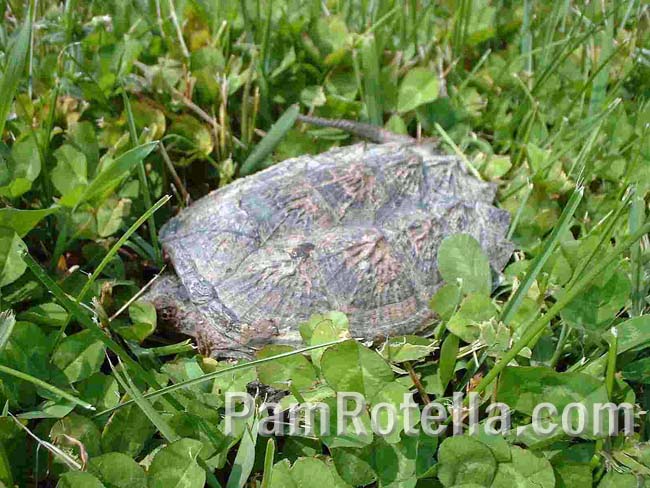 I put the tortoise in the tall grass between the road and the ditch. I just hope the tortoise isn't in the farmer's field when he decides to seed or harvest there. Realistically, it'll probably find its way to the road again, to get some sun. That's the problem even on rural roads -- not enough habitat for the tortoises to roam. I could have taken it to a nearby park, but then it would be close to another road, train tracks, and a river. Plus it would be out of the environment where I found it. I don't know if it could survive in a different habitat.
I put the tortoise in the tall grass between the road and the ditch. I just hope the tortoise isn't in the farmer's field when he decides to seed or harvest there. Realistically, it'll probably find its way to the road again, to get some sun. That's the problem even on rural roads -- not enough habitat for the tortoises to roam. I could have taken it to a nearby park, but then it would be close to another road, train tracks, and a river. Plus it would be out of the environment where I found it. I don't know if it could survive in a different habitat.The tortoise was very hard to spot in the tall weeds -- it looks like a small rock or patch of pavement, and would be impossible to spot casually. I'm sure the dog won't find it without a lot of luck. Its worst danger is its own habit of basking on the pavement.
Another tortoise! On Wednesday, 5/29/02, I was test-driving my car after a repair, with the mechanic on board. Suddenly I stopped the car, explaining to my mechanic that I noticed another tortoise on the road. He was supportive of me stopping to take it out of harm's way. We were in a heavily wooded, hilly area, and cars coming from the opposite direction might not see the tortoise soon enough after a curve to stop for it. There was no shoulder, but the road was deserted enough for me to stop and back up. The box turtle immediately retreated into its shell, and closed its bottom "hinge".
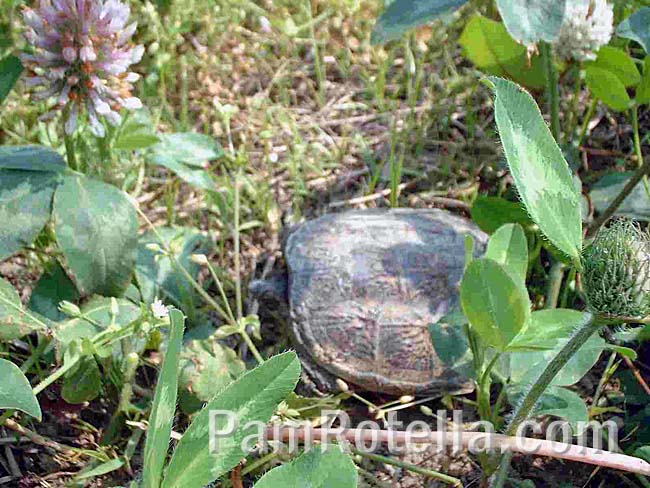 The mechanic told me to put it in the woods, in the direction it was heading. This was early in the evening, and the temperature was a little cool outside with very little sunlight hitting the road. I don't think the tortoise was getting any extra heat from the road at the time, but it may have been using the road due to habit, or a need to cross the road (although it didn't seem to be moving when I first saw it). I wonder why there's so much tortoise activity lately -- perhaps it has something to do with mating season.
The mechanic told me to put it in the woods, in the direction it was heading. This was early in the evening, and the temperature was a little cool outside with very little sunlight hitting the road. I don't think the tortoise was getting any extra heat from the road at the time, but it may have been using the road due to habit, or a need to cross the road (although it didn't seem to be moving when I first saw it). I wonder why there's so much tortoise activity lately -- perhaps it has something to do with mating season.The box turtle (box tortoise) I rescued today was black except for pretty orange-yellow designs on each section of its shell -- beautifully ornate. I wish I could have taken pictures, but the mechanic was waiting and my car was parked on the curvy road in a precarious location. So I can't share how cute it is with the world, but I'll at least give a brief description: the tortoise's shell was slightly smaller than a dinner plate (about the size of a salad plate) in circumference, and a few inches tall -- maybe 3-4 inches. I was glad to help, and can only hope the experience will keep it off of the road in the future.
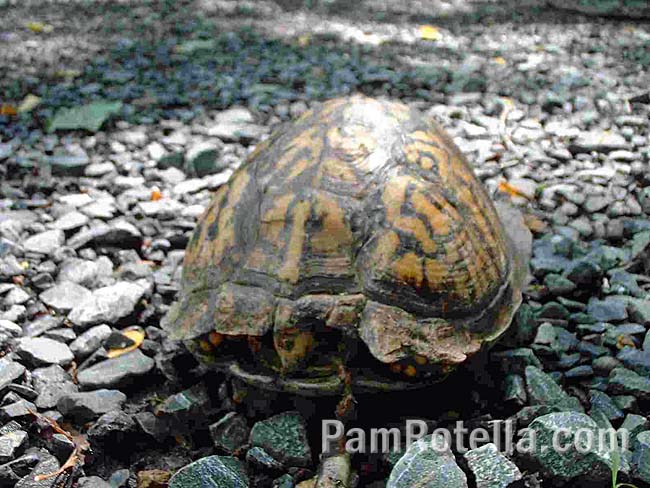 Yet another tortoise! Friday, June 7th, I found yet another tortoise (box turtle), but I don't understand why it chose my friends' gravel and dirt drive for a rest. Perhaps because the area is well-drained, after 2 days of heavy rain and thunderstorms. It wasn't a warm location for sunning -- the area is heavily wooded with very little direct sunlight reaching the drive, which was cold and wet like everything else this morning. This time, I took the tortoise in the car for a few hundred feet, to a small clearing with direct sunlight and nearby pond. The tortoise had stopped in an area where the drive had steep slopes on both sides, and there was no place to put it on the side of the drive where I found it. I'm sure it was terrified, but now it has room to move around without being run over by a car.
Yet another tortoise! Friday, June 7th, I found yet another tortoise (box turtle), but I don't understand why it chose my friends' gravel and dirt drive for a rest. Perhaps because the area is well-drained, after 2 days of heavy rain and thunderstorms. It wasn't a warm location for sunning -- the area is heavily wooded with very little direct sunlight reaching the drive, which was cold and wet like everything else this morning. This time, I took the tortoise in the car for a few hundred feet, to a small clearing with direct sunlight and nearby pond. The tortoise had stopped in an area where the drive had steep slopes on both sides, and there was no place to put it on the side of the drive where I found it. I'm sure it was terrified, but now it has room to move around without being run over by a car.When I first stopped my car, the tortoise was relaxed, standing on its legs with its head out, although not moving. After I left the car and approached on foot, it immediately retreated into its shell, but as this photo shows, hesitated before closing the shell entirely. This photo was the last I'd see of its face.
Its shell is much more yellow than the box turtle I found many miles away, when driving with my mechanic. The other tortoise had very small, thin designs on its shell, like calligraphy. This tortoise's shell is almost leopard-like. I'm sure it's good camouflage in August, when yellow leaves fall to the ground in this northern climate.
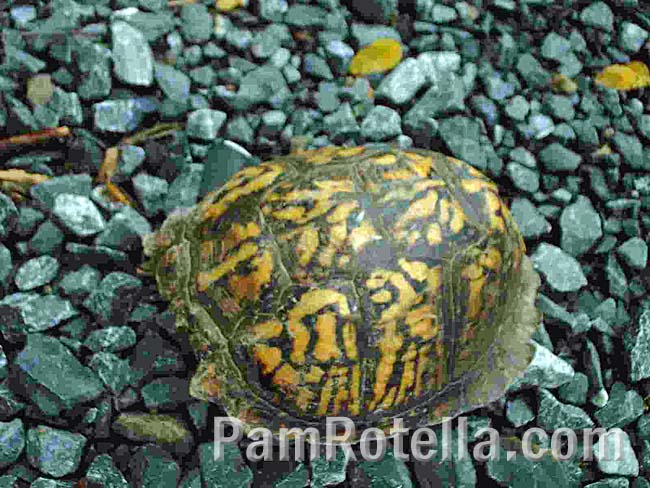 Before finding a place to relocate the animal, I turned it over to check the condition of its shell. Surprisingly, the shell seemed worn with cracks and a hole. I wonder if a dog punctured the bottom of its shell; neighbors in the area do have large dogs that sometimes visit the property. Or perhaps it had fallen down a slope in the area. I was amazed at how tightly its shell closed. It seemed to be healthy even with its worn bottom shell, so I looked for a place to relocate the reptile as quickly as possible.
Before finding a place to relocate the animal, I turned it over to check the condition of its shell. Surprisingly, the shell seemed worn with cracks and a hole. I wonder if a dog punctured the bottom of its shell; neighbors in the area do have large dogs that sometimes visit the property. Or perhaps it had fallen down a slope in the area. I was amazed at how tightly its shell closed. It seemed to be healthy even with its worn bottom shell, so I looked for a place to relocate the reptile as quickly as possible.After thinking of the first tortoise relocation this year, I wanted to find a place with room for the animal to wander, even if it meant driving the tortoise to a nearby location. I thought of the large dogs in the area, and of my friends' own dog on the property. Driving it to their yard, although spacious, wasn't an option.
Instead, I drove the box turtle to a nearby clearing and pond, frequented by a few local geese. Hopefully the tortoise will find enough room for living without needing roads again.
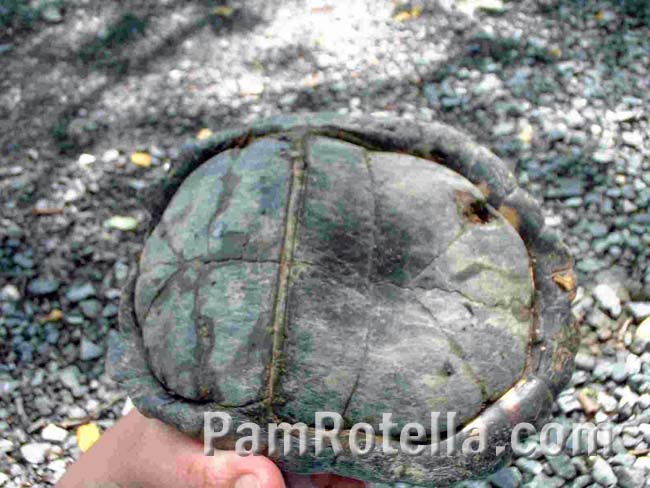 These relocations remind me of a lizard I wanted to rescue from a road near an entrance to Yosemite National Park in California. I forget the exact year -- probably 1997. It was the year Yosemite was constructing some sort of theater, before hikers were killed in the area by a rock slide (which was probably caused by the construction's destabilization of the area). As I was leaving Yosemite, I saw a pretty orange and black lizard on the road, sunning itself. I slowed down as I passed and leaned out of the open car window. It seemed as if the lizard was looking up at me, almost smiling. I knew the lizard was in immediate danger of being run over if I left it there, so I did a U turn and parked across the street. However, before I could cross the road on foot, a big orange construction vehicle from Yosemite itself ran the lizard over with its giant black tires. I drove past the lizard again to look at it. It wasn't completely flattened, but its sides looked as though they were coming apart at the seams. I felt awful for the lizard, and thought about it for months after that.
These relocations remind me of a lizard I wanted to rescue from a road near an entrance to Yosemite National Park in California. I forget the exact year -- probably 1997. It was the year Yosemite was constructing some sort of theater, before hikers were killed in the area by a rock slide (which was probably caused by the construction's destabilization of the area). As I was leaving Yosemite, I saw a pretty orange and black lizard on the road, sunning itself. I slowed down as I passed and leaned out of the open car window. It seemed as if the lizard was looking up at me, almost smiling. I knew the lizard was in immediate danger of being run over if I left it there, so I did a U turn and parked across the street. However, before I could cross the road on foot, a big orange construction vehicle from Yosemite itself ran the lizard over with its giant black tires. I drove past the lizard again to look at it. It wasn't completely flattened, but its sides looked as though they were coming apart at the seams. I felt awful for the lizard, and thought about it for months after that.I'd never seen another lizard like it, and was interested in learning what species of lizard the orange and black victim had been. I was able to find a few pictures on the internet which indicated its markings were those of a Gila monster -- one of two poisonous lizards in the Western hemisphere. (The other poisonous lizard is the beaded lizard of Mexico.) However, all the web sites indicated Yosemite was far north of the desert-dwelling Gila monster's range. Was it possible that a Gila monster found its way to Yosemite, or that a few Gila monsters live there? Please e-mail me if you have any information on this.
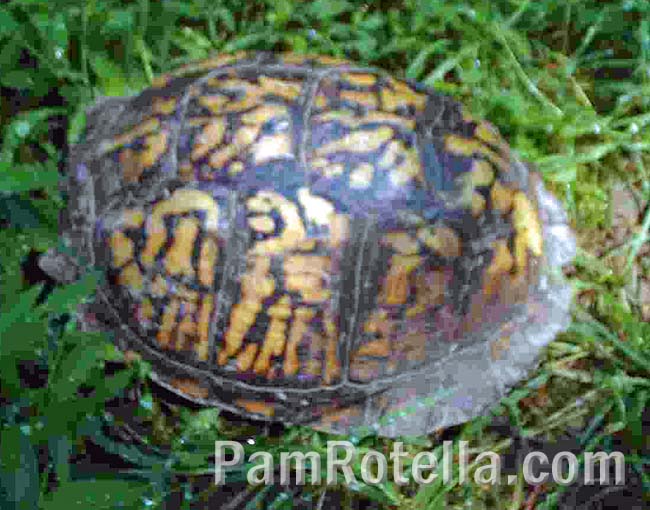 Although the Gila monster is poisonous, I've since seen television shows explaining that they're very docile, and human deaths from Gila monster bites are very rare. It's not like picking up a venomous snake. Gila monsters' venom is in their lower teeth, and they have to chew it into their victim. So the lizard probably wouldn't have harmed me (although I'm not recommending that anyone try to pick one up). But even if I'd been able to rescue it, I realize it's unlikely the lizard would have survived, living near the road. Nevertheless, I still feel compelled to move animals out of harm's way whenever it's possible to do so safely. Some of those animals may go on to live the rest of their natural lives without harm, and a few minutes of my time is certainly worth giving them that chance.
Although the Gila monster is poisonous, I've since seen television shows explaining that they're very docile, and human deaths from Gila monster bites are very rare. It's not like picking up a venomous snake. Gila monsters' venom is in their lower teeth, and they have to chew it into their victim. So the lizard probably wouldn't have harmed me (although I'm not recommending that anyone try to pick one up). But even if I'd been able to rescue it, I realize it's unlikely the lizard would have survived, living near the road. Nevertheless, I still feel compelled to move animals out of harm's way whenever it's possible to do so safely. Some of those animals may go on to live the rest of their natural lives without harm, and a few minutes of my time is certainly worth giving them that chance.© 2002 by Pam Rotella
Other articles from pamrotella.com
Omega-3 fatty acids -- the "good fats" we all need
Genetics and the cure for cystic fibrosis, cancer, or OCD
Mad Cow and Mark Purdey's Organophosphate theory
Dr. Lawrence Broxmeyer and the bacterial model of Mad Cow Disease
Alternative medicine vs. the common cold and flu
Dr. Hulda Clark -- scientifc genius, and the cure for cancer and AIDS
Diet sodas (aspartame), MSG, and Excitotoxins
Pam's 1,000+ page photo gallery (No membership required!)
The famous Dick Cheney cartoon -- What Would Dick Cheney Look Like?
Back to the top
Back to Pam's vegan vegetarian FUN page
Pam's vegan vegetarian cookbook, with vegan vegetarian recipes